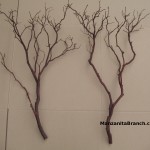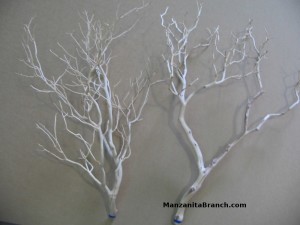Buy Natural Manzanita Branches
Buy Sandblasted Manzanita Branches
 Each Branch Is Extremely Unique
Each Branch Is Extremely Unique
One of the exciting things about ordering manzanita branches is, you never know what you are going to get. Each branch is very different. Some are more full than others, some have larger diameter stems than others. Some have more forked stems, and the potential variations are endless.
When harvesting our manzanita branches, we make sure each centerpiece grade piece looks good enough to be able to stand alone. Many people like to combine several branches to make a more full centerpiece. This is obviously an option with our branches, but if a piece doesn’t have enough character to stand alone, it becomes something else, such as a bird perch, or will be sold as filler material. When comparing prices between suppliers, consider how many branches you may have to combine to get the full arrangement you want.
Variations Between Branches
There are many factors that can cause wide variations in branches. Styles can depend a lot on the location of the harvest. Manzanita typically grows in mountainous areas where growing conditions greatly vary in sun exposure, soil conditions, climate, overcrowding, competing vegetation, etc. These variables affect the way manzanita grows and the shape of the branches. Branches harvested one month may look very different from ones being harvested the next which may be harvested from a different location.
Age is also a factor. Young manzanita typically has a different look than more mature manzanita. Sometimes the younger material will have a more bushy structure, but often less character. It’s the older pieces that commonly have more character, especially in the stems, but often more delicate and sometimes more sparse twigs.
What to Expect From Manzanita
Wood cracks as it dries, especially in its natural round form. Not only is manzanita not an exception, it is one of the woods that is more likely to crack. The cracks will be in the thicker stem wood, and they run parallel to the stems. This is normal and will not cause them to break. It’s simply the nature of wood, especially round wood. You can think of it as added character, or use a filler material, such as wood putty, to fill them in.
If the material is harvested from late spring through mid summer, expect the bark to peel. The thin layer of outer bark is shed this time of year and replaced with the new layer underneath. As the bark cracks and curls away from the stems, it can be brushed off. This can be considered an inconvenience, or considered an interesting part of its character. With sandblasted pieces, this is of course not an issue.
Manzanita bark will darken some and lose some of its luster as it dries. But if kept indoors and out of the weather, it will last a long long time.
Sandblasted Manzanita Branches
 Sandblasting manzanita branches removes the bark to reveal the whitish wood underneath. The color of the wood can vary with age, time of year it was harvested, and how dry it is. Sandblasting is a very harsh process that not only blasts off the bark, but also some of the smaller more delicate twigs. Because of this, sandblasted branches are usually more sparse and less bushy.
Sandblasting manzanita branches removes the bark to reveal the whitish wood underneath. The color of the wood can vary with age, time of year it was harvested, and how dry it is. Sandblasting is a very harsh process that not only blasts off the bark, but also some of the smaller more delicate twigs. Because of this, sandblasted branches are usually more sparse and less bushy.
A sandblasted branch will crack the same as a natural branch. Although the cracks can be less noticeable at a glance since there is less color contrast without the bark.
On older manzanita, there are often areas of dead wood exposed on the surface. Sandblasting cleans up the usually grayish weathered outside layer of this dead wood, and exposes the reddish to brownish shades underneath. These areas can be absolutely beautiful, especially in contrast to the whitish live wood.